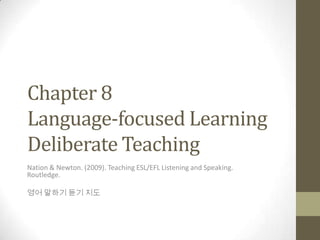
Language-focused Learning Advantages and Limitations
- 1. Chapter 8 Language-focused Learning Deliberate Teaching Nation & Newton. (2009). Teaching ESL/EFL Listening and Speaking. Routledge. 영어 말하기 듣기 지도
- 2. Advantages 1. A combination of language-focused learning and meaning-focused use leads to better results than either kind of learning alone. 2. Language-focused learning can speed up the rate of second language acquisition. 3. Language-focused learning may help learners to continue to improve their control of grammar rather than becoming stuck with certain errors. 4. Some language-focused learning can lead directly to acquisition, depending on the kinds of items focused on, especially vocabulary (Elgort, 2007). 5. Language-focused learning can indirectly provide meaning-focused input.
- 3. Limitations 1. Language-focused learning cannot change the order in which learners acquire certain complex, developmental features of the language, such as questions, negatives, and relative clauses. 2. Language-focused learning needs to be combined with the opportunity to use the same items in meaning-focused use. 3. Some grammatical items learned through language-focused learning may only be available to the learner in planned use.
- 5. The strategy for voca learning The best language-focused vocabulary instruction involves looking at a word as part of a system rather than as part of a message. This means paying attention to regular spelling and sound patterns in words, paying attention to the underlying concept of the senses of words (head of the school, head of a bed, head of a match . . .), paying attention to word building devices, giving attention to the range and types of collocations of a word, and paying attention to the range of clues to the word’s meaning provided by context.
- 6. Vocabulary Instruction 1. Speeds up the rate of learning, both in terms of quantity and quality 2. Builds implicit knowledge: the vocabulary is subconsciously and fluently available for use 3. Speeds up the development of explicit knowledge
- 7. Vocabulary Range • The most important 2000 to 3000 word families make up such a large proportion of both spoken and written use. • To cope with unsimplified spoken language, a vocabulary size of around 6000 word families is needed (Nation, 2006).
- 8. Focus of Instruction • Vocabulary List – High frequency words • Learning and coping strategies (e.g. Using context for making inference, Using mnemonics) • Andy Bell’s Link Method http://youtu.be/X-xl7_hdWZo http://youtu.be/9NROegsMqNc
- 9. General Service List • “The General Service List (GSL) (West. 1953) is a set of 2,000 words selected to be of the greatest "general service" to learners of English. They are not the most common 2,000 words, though frequency was one of the factors taken into account in making the selection. Each of the 2,000 words is a headword representing a word family that is only loosely defined in West.” • http://jbauman.com/aboutgsl.html
- 10. Academic Word List • “Academic Word List Coxhead (2000). The most frequent word in each family is in italics. There are 570 headwords and about 3000 words altogether. For more information see The Academic Word List .” • http://www.uefap.com/vocab/select/awl.htm
- 11. Monitoring Voca Learning “Levels of Processing” Viewpoint (Craik and Tulving, 1975; Baddeley, 1990: 160–173) 1. Are the learners giving attention to more than one aspect of the word? For example, meaning, form, use. 2. Are the learners being original and creative in the way they look at the word? 3. Are the learners relating the word to previous knowledge?
